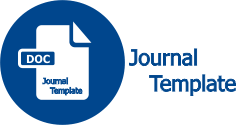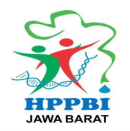Selection of Proteolytic Bacteria from Bonoloyo Public Burial Place (PBP), Banjarsari, Surakarta, Central Java
DOI:
https://doi.org/10.25134/quagga.v16i1.57Keywords:
Proteolytic Bacteria, Proteolytic Index, Public Burial Place, Milk Agar Scheme (SMA), Bacterial ColoniesAbstract
Public Burial Place (PBP) is a cemetery for everyone. In PBP, protein decomposition occurs actively because the human body is made up of 16.4% protein, so it is most likely that proteolytic bacteria can be found. Previous research has isolated as many as 45 isolates from PBP Bonoloyo, Surakarta, but has not selected their proteolytic capabilities. The aim of the study was to isolate proteolytic bacteria from the Bonoloyo Public Cemetery and identify them. The bacterial isolate of PBP Bonoloyo is a collection from the FKIP Biological Laboratory of Muhammadiyah University of Surakarta that selected its proteolytic capabilities using the milk agar scheme (SMA). The parameters measured are the diameter of the colony and the lymphatic zone formed to obtain the value of the proteolytic index (IP). For bacterial isolates showing a positive proteolytic activity, simple identification is carried out through the observation of colonial morphology and Gramme colouring. The results of the study showed that as many as 28 isolates (62.2%) were positive for proteolytic activity, with IP values >2 for B1 and B3. Bacterial proteolytic isolates are dominantly white to yellow with irregular, filamentary, spindle, and circular colonial forms. The results of Gramme colouring show that bacterial isolates that have proteolytic abilities are a group of Gramme negative bacteria that are basil shaped. The bacterial isolate that shows the highest IP value is the B1 isolate, which is suspected to be of the genus Bacillus. This research obtained data showing that in the public cemetery (PBP), Bonoloyo stores potential as a proteolytic bacterial habitat for a group of Gramme negative bacteria.
References
Ahmad, B., Nigar, S., Sadaf Ali Shah, S., Bashir, S., Ali, J., Yousaf, S., & Bangash, J. A. (2013). Isolation and identification of cellulose degrading bacteria from municipal waste and their screening for potential antimicrobial activity. World Applied Sciences Journal, 27(11), 1420–1426. https://doi.org/10.5829/idosi.wasj.2013.27.11.81162
Ainiyah, D., &; Shovitri, M. (2014). Plastic Degrading Garbage Soil Bacteria in Winogradsky Columns. Pomits' Journal of Science and Art, 3(2), 63–66.
Asril, M., &; Leksikowati, S. S. (2019). Isolation and Selection of Proteolytic Bacteria from Tofu Liquid Waste as the Basis for Determining Biofertilizer Making Agents. Elkawnie, 5(2), 86. https://doi.org/10.22373/ekw.v5i2.4356
Badriyah, B. I., Ardyati, T., Microbiology, L., Biology, J., Brawijaya, U., Malang, J. V., & Timur, J. (2013). Detection of proteolytic activity of bacterial isolates of tofu pulp origin on bran substrates. 1(3).
Brilliana Putra, A., Fakhrurizal Amin, I., Dini Fitriyasa, R., &; Safitry, O. (2020). Estimating the Time of Death (Postmortem Interval) Using Microbiome Findings at Each Stage of Decomposition: An Evidence-Based Case Report. Journal of Indonesian Forensic and Legal Medicine, 2(1), 111–122.
Fineza, A. G., Marques, E. A. G., Bastos, R. K. X., & Betim, L. S. (2014). Impacts on the groundwater quality within a cemetery area in southeast Brazil. Soils and Rocks, 37(2), 161–169.https://doi.org/10.28927/sr.372161
Hastuti Sri, U., Febriani, S., &; Asna, P. M. A. (2017). Identification and determination of protein hydrolysis index in proteolytic bacteria from mangrove soil in Margomulyo, Balikpapan. Proceedings Biology Education Conference, 14(1), 265–270.
Ibrahim, A. S. S., Al-Salamah, A. A., Elbadawi, Y. B., El-Tayeb, M. A., & Shebl Ibrahim, S. S. (2015). Production of extracellular alkaline protease by new halotolerant alkaliphilic Bacillus sp. NPST-AK15 isolated from hyper saline soda lakes. Electronic Journal of Biotechnology, 18(3), 236–243. https://doi.org/10.1016/j.ejbt.2015.04.001
Indrayani, D., Widayati, R., &; Budiman, E. (2021). MODERN CREMATORIUM AND COLUMBARIUM PLANNING OF SAMARINDA CITY. Journal of Civil Science and Technology, 5, 1–6.
Lestari, D. A., Muchlissin, S. I., Mukaromah, A. H., Darmawati, S., &; Ethica, S. N. (2018). Isolation of Protease Enzyme-Producing Bacteria Bacillus megaterium IROD3 from Red Oncom After 72 Hours Fermentation. National Seminar on Edusainstek FMIPA UNIMUS 2018, 1(1), 31–39. https://jurnal.unimus.ac.id/index.php/psn12012010/article/view/4235
Linda, T. M., Devi, S., Roza, R. M., Maryana, &; Silaban, D. U. (2015). Alkaline protease activity by alkalitolerant thermophilic bacteria from hot spring reservoirs of Sungai Pinang Village, Kuantan Singingi Regency, Riau. In Tanjungpura University Pontianak – city: Pontianak (pp. 351–358).
Lobo, O. L. L., Rupidara, A. D. N., & Ledo, M. E. S. (2022). SELEKSI ENZIM PROTEASE JAMUR ENDOFIT DAUN MANGROVE Avicennia marina DI PANTAI NOELBAKI. 5(3).https://doi.org/10.33323/indigenous.v5i3.267
Mahajan, R. T., & Badgujar, S. B. (2010). Biological aspects of proteolytic enzymes : A Review. Journal of Pharmacy Research, 3(9), 2048–2068.
Mahdiyah, D. (2015). Isolation of bacteria from peat soil producing protease enzymes. Journal of Pharmascience, 2(2), 73.
Majgier, L., Rahmonov, O., & Bednarek, R. (2014). Features of abandoned cemetery soils on sandy substrates in Northern Poland. Eurasian Soil Science, 47(6), 621–629. https://doi.org/10.1134/S1064229314060064
Mehrnoush, A., Mustafa, S., Sarker, M. Z. I., & Yazid, A. M. M. (2011). Optimization of the conditions for extraction of serine protease from kesinai plant (streblus asper) leaves using response surface methodology. Molecules, 16(11), 9245–9260. https://doi.org/10.3390/molecules16119245
Muharni, Juswardi, &; Prihandayani, I. (2013). Isolation and identification of protease-producing thermophilic bacteria from Tanjung Sakti Lahat Hot Springs, South Sumatra. Proceedings of Semirata FMIPA University of Lampung, 1(1), 139–143.
Nurfazri, A., Ulwan, N. N., &; Priambodo, R. (2021). Recommendation System for Optimization of Grave Plot Selection in PBP using Web-Based Simple Additive Weighting Method. Journal of Sisfokom (Information Systems and Computers), 10(1),1–9. https://doi.org/10.32736/sisfokom.v10i1.934
Nurhayati, I. S., &; Martindah, E. (2015). Control of Subclinical Mastitis through Antibiotic Administration During the Dry Period in Dairy Cows. Wartazoa, 25(2), 065–074.
Oktavia, D. A., Nursyirwani, N., & Yoswaty, D. (2022). OPTIMIZATION OF THE GROWTH OF PROTEOLYTIC BACTERIA Bacillus toyonensis AT DIFFERENT SALINITY AND CONCENTRATION OF TOFU WASTEWATER. Asian Journal of Aquatic Sciences, 5(2), 176–183. https://doi.org/10.31258/ajoas.5.2.176-183
Parinduri, A. G. (2020). Textbook of Forensic and Medicolegal Medicine. UMSU Press, 417.
Putra, S. S., Rahayu, T., & Tyastuti, E. M. (2023). Isolasi dan Karakterisasi Bakteri Rizosfer Pohon Kamboja (Plumeria acuminata) di TPU Pracimaloyo sebagai penghasil IAA. Bioeduscience, 7(1), 15–23. https://doi.org/10.22236/jbes/7111375
Puspitasari, F. D., Shovitri, M., &; Kuswytasari, N. D. (2012). Isolation and Characterization of Proteolytic Aerobic Bacteria from Septic Tanks. ITS Journal of Science and Art, 1(1), 1–4.
Rahmadian, C. A., Ismail, Abrar, M., Erina, Rastina, &; Fahrimal, Y. (2018). Isolation and identification of Pseudomonas sp bacteria in salted fish at the Labuan Haji fish auction site, South Aceh. Jimvet Journal, 2(4), 493–502.
Razzaq, A., Shamsi, S., Ali, A., Ali, Q., Sajjad, M., Malik, A., & Ashraf, M. (2019). Microbial proteases applications. Frontiers in Bioengineering and Biotechnology, 7(JUN), 1–20. https://doi.org/10.3389/fbioe.2019.00110
Sabdaningsih, A., Budiharjo, A., &; Kusdiyantini, E. (2013). Isolation and morphological characterization of colonies of red algae association bacteria (Rhodophyta) from Bali Kutuh waters. Journal of Biology, 2(2), 11–17.
Try Upayogi, I. N. (2019). Kajian Eksplanasi Taru Menyan Penetral Bau Mayat. Jurnal Filsafat Indonesia, 2(1), 37. https://doi.org/10.23887/jfi.v2i1.17550
Winarni, S. (2018). Ethics, Religious Rules related to Health.
Yahdiyani, N., Hidayatulloh, A., &; Nurhayati, L. S. (2021). The Potential of Proteolytic Bacterial Isolate from the Process of Making Organic Fertilizer as a Starter for Livestock Waste Treatment. Journal of Livestock Product Technology, 2(1), 17. https://doi.org/10.24198/jthp.v2i1.31321
Yuliasih, & Nurdin, F. (2020). Analisis Body Composition Masyarakat Desa Karang Tengah Kabupaten Bogor. Jurnal Segar, 9(1),14–20. https://doi.org/10.21009/segar/0901.02

















